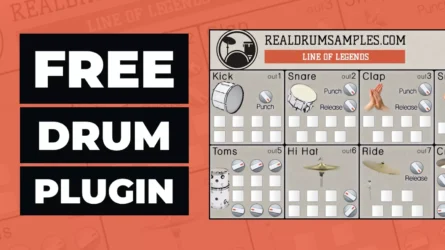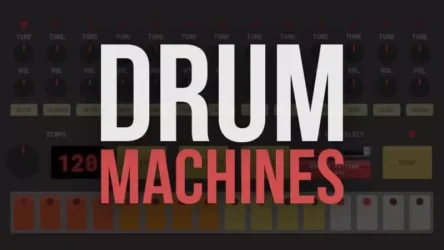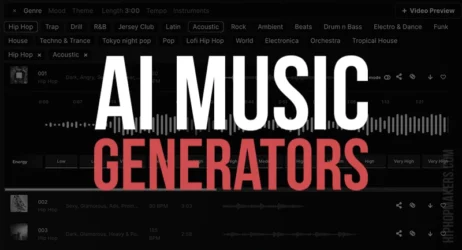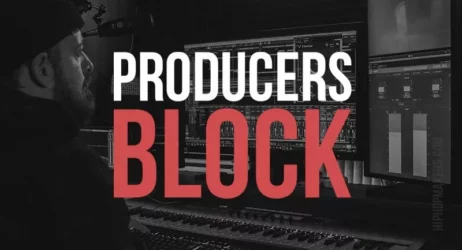This quick start guide will answer what is an octave in music, examples of octaves, number of octaves, and other important common questions.
- What Is An Octave in Music
- What Is An Example of An Octave
- How Many Octaves Are There
- How Many Notes Are In A Octave
- What Is An Octave On The Piano
- How Many Octaves On A Piano
- What Does 1 Octave Higher Mean
- Why Is It Called An Octave
What Is An Octave in Music?
An octave is an interval between one musical pitch and another with half or double its frequency. An octave spans eight musical notes. This means that they are the next note up or down, ranging from A to G on pianos. Octaves were first introduced as a way of organizing and structuring music.
The word “Octave” originates from the Latin language. The “octa” part translates into “eight,” as in the eight-note interval between the octave note played.
Much to the confusion surrounding the name was the relation of frequency of the octave note.
The frequency becomes twice the previous note and not eight times before; this is just a common misconception.
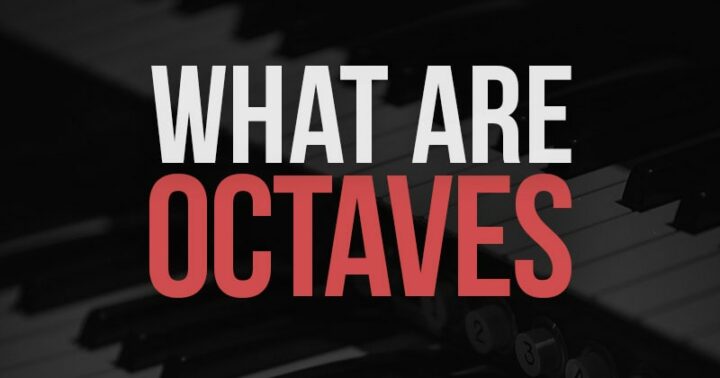
Octave in music is defined as the distance between the two musical notes of the same letter but twice the difference in the pitch of the respective notes. There has to be an interval of eight notes to complete a cycle to qualify as an octave in music.
The musical letters are the following: A, B, C, D, E, F, G. When the sequence repeats itself is when an octave is completed, and if it is played in ascending order, then it means the note which is being played is “one Octave Higher.”
Meaning, the frequency has doubled since the first note after a single octave.
If note A3 has a frequency of 220 Hz, then by applying the above rule, we can calculate that A4will have 440 Hz, and so A5 will have 880 Hz frequency.
We can reach an Octave of note A by repeating the full cycle repeatedly, such as A3, B, C, D, E, F, G, A4.
Thus, the upper A3 is accepted as qualitatively identical to the lower A4, the only difference being twice the higher pitch.
The melody orchestrated with an octave is caused by doubling the pitch of the same note for harmonization of the said musical piece.
There total of 8 notes in a single octave, and if we were to break them even further down, then it would consist of 12 semi-notes as follows” C, C#, D, D#, E, F, F# G G# A, A#, B.
Our ears have a hearing range of about 20Hz to 20,000Hz (or 20kHz). There are about ten octaves in music.
What Is An Example of An Octave?
Music with octaves is always appreciated as classical tunes. The audio becomes richer and more harmonious when the octave of a single note is played, allowing the composer to stand out among the barrage of music being produced everywhere.
An incredible amount of sharp skill and talent is needed to orchestrate such a piece. Here is a short list of examples of an octave in music:
- Wes Montgomerym, who was a famous jazz guitarist, played solo octaves instead of single notes.
- György Ligeti, a renowned Hungarian composer from the 20th century, created a masterpiece using octaves in his eleven-part piano suite called “Musica Ricercata.” He limited the constant number of pitches used in each part of the musical piece. Which was even used in a movie named “Eyes Wide Shut.”
- Composer Harold Arlen’s song “Somewhere Over the Rainbow” used octave in the opening notes and played the hit movie “Wizard of Oz.”
- The golden disco era relied heavily on bass lines using octaves in a limited eighth note cycle.
- Rock music guitarist uses Digitech Whammy guitar pedals which allows players to pick up on octaves.
How Many Octaves Are There?
The lowest audible sound note has a frequency of 16.35Hz, referred to as note C:” C0″. Now with every other octave in music, the pitch of it becomes twice the note.
If we start with a “C0” and move to a “C4,” then we would reach a frequency of 261.63 Hz as the particular “C4” note is the middle C which has four octaves.
Therefore we would need to multiply the frequency of “‘ C0” by four; that is, 16.35*4 equals 261.63 Hz.
We reach the eighth octave, “C8”, similarly until finally the sound note with the borderline of the human frequency hearing range approaches.
This “C10” note has a pitch of about 16744.04 Hz or 16.7 kHz, basically ten octaves above the base C note.
Any pitch below this range can be classified as rhythms, but if it were to be considered octaves, we would get four extra ones increasing the total to 14 octaves in music.
How Many Notes Are In A Octave?
There are eight notes in an octave in music. The breakdown of the latter is as follows:
Diatonically
7 notes, with the 8th note being the octave of the 1st note
Semitone Wise
12 semitones (half steps) from the first note
Interval Wise
One note to start at and another note directly above or below the first note.
The major 8 notes can be further divided into 12 semi-notes as:
- A = 440 Hertz
- B flat = 466 Hertz
- B = 494 Hertz
- C = 523 Hertz
- C sharp = 554 Hertz
- D = 587 Hertz
- D sharp = 622 Hertz
- E = 659 Hertz
- F = 698 Hertz
- F sharp = 740 Hertz
- G = 784 Hertz
- A flat = 831 Hertz
- A = 880 Hertz
What Is An Octave On The Piano?
The octave on the piano refers to the intervals between the notes having twice the frequency difference, and the notes can explain a single octave played on 5 black keys and 7 white keys on the keyboard.
The first C note is on the outside left of the two black keys. Afterward, the next C will be one octave higher and easily located by counting the musical alphabets until C is reached. For example, C D E F G A B C.
Before the creation of modern-day piano, musicians in the Renaissance and Baroque era composed music for the harpsichord.
This instrument had sixty keys, worked by plectrum stroke on the internal strings compared to the hammer strokes of the existing piano of that time. The harpsichord had a five-octave musical range.
In the early 1700s, an Italian man named Bartolomeo Cristofori, a harpsichord mechanic and musical instrument technician by profession, invented a never-seen-before style keyboard with a damper and hammer system.
This became the foundation of what pianos are today. Thus, this was expanded to and more musically expressive instrument with a seven-octave keyboard.
How Many Octaves On A Piano?
In the early 1700s, 60 key instruments called harpsichords had a musical range of five octaves. Afterward, it was developed over the next hundred years, and by the late 1800s, the instrument evolved into a 7 Octave keyboard.
The standard 88-key piano, which includes 52 white keys and 36 black keys, was developed by Steinway in the 1880s.
This can compose up to 7 octaves and 3 additional ones below the “C0” note. This piano features each octave having 5 black keys and 7 white keys on the keyboard.
The modern grand, digital, or uptight piano generally has 7 and one-quarter octaves which means seven full octaves and 3 extra treble notes such as B, B-flat, and C.
The standard piano has 88 keys and 7 octaves, but there can be exceptions. In 2018, a world record was broken with a 108-key piano which had a whopping 9 octaves.
Bosendorfer, manufactures a 97-key piano with nine additional keys present at the bottom of the instrument.
What Does 1 Octave Higher Mean?
One octave higher simply refers to a note of higher frequency playing of the same musical letter. The musical letters are the following: A, B, C, D, E, F, G. When the sequence repeats itself is when an octave is completed, and if it is played in ascending order, then it means the note which is being played is “one Octave Higher.”
For example, the note of D is being played on a keyboard. We would start with the note D and continue in sequence of “D, E, F, G, A, B, C, D.”
The last D signifies the completion of an octave on a higher pitch of the same letter. Every time a full cycle is completed, it will end one octave higher than previously.
Why Is It Called An Octave?
The word “octave” comes from a Latin background meaning “eight.” An octave is an interval between two musical notes that have the same letter name.
It seems an odd name for a pitch that is double and not eight times higher because it is not named after the increment of frequency but rather named after the distance between the musical letters that qualify a single octave.
The next frequency is called the octave because it is the eighth note. Thousands of years back, the letters of the Roman alphabet were adopted to refer to musical notes, and since there were only seven, the letters ran A, B, C, D, E, F, G., So the 8th letter is the repetition of the note, just one octave higher.
The octaves were named by composers who divided them into scales for example:
In scale ‘do-re-mi-fa-sol-la-si-do,’ the distance between first and last make an octave in music. The eight notes that make the octave justify the Latin part of the label, which is ‘Octo.’
Summary of Octaves in Music
An Octave in music refers to the interval between a single musical note with either half or double the pitch of the previous note, and the note has to be of the same musical letter.
The octave in music occurrence has been dubbed as the “Basic miracle of music” as its usage is common in the majority of the musical systems.
They were created to give musicians an easier way of understanding scales and how different notes sound when they are played together.
Understanding octaves in music allows us to grasp the concept of pitch and musical intervals.
By recognizing that two notes an octave apart have the same name and share a fundamental frequency, we can appreciate how octaves are crucial in various aspects of music.
From playing octaves on piano keys to identifying the octave interval in a major or minor scale, octaves play a significant role in creating harmonious melodies.
By separating notes by octaves, musicians can explore different pitches and create beautiful sound waves through multiple octaves, higher or lower.
Whether it’s the first and last notes of a diatonic or chromatic scale or the same notes played with different octaves, octaves provide us with a versatile tool to express ourselves in Western music.
With the help of octave equivalence and the understanding of intervals in music, we can navigate the world of musical scales and intervals, utilizing whole steps and half steps to create captivating compositions in many ways.
I hope we answered what an Octave is in music, and you now have a better understanding how they are used.

